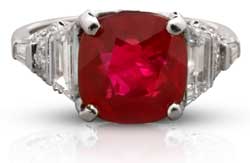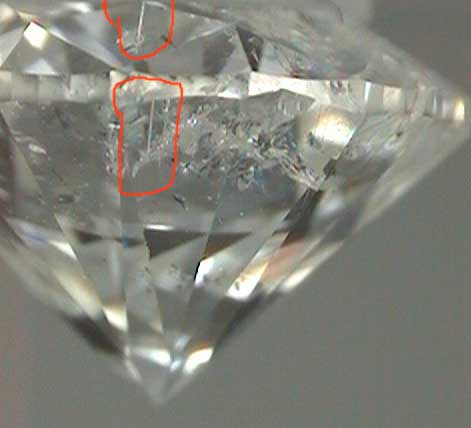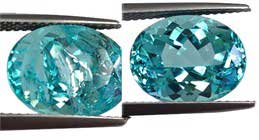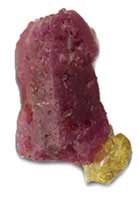Exploring the 4 Cs:
Clarity – for all transparent gems
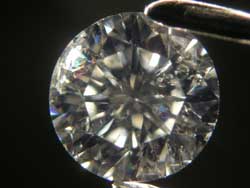 There are many jewelry gemstones where clarity doesn't come into play, gems like pearls, jade, or coral. But for transparent gems—diamond, emerald, ruby, sapphire, and many others—their transparency is a show-off quality, and clarity is its measure.
There are many jewelry gemstones where clarity doesn't come into play, gems like pearls, jade, or coral. But for transparent gems—diamond, emerald, ruby, sapphire, and many others—their transparency is a show-off quality, and clarity is its measure.
 There are many jewelry gemstones where clarity doesn't come into play, gems like pearls, jade, or coral. But for transparent gems—diamond, emerald, ruby, sapphire, and many others—their transparency is a show-off quality, and clarity is its measure.
There are many jewelry gemstones where clarity doesn't come into play, gems like pearls, jade, or coral. But for transparent gems—diamond, emerald, ruby, sapphire, and many others—their transparency is a show-off quality, and clarity is its measure.Most mined gems have inclusions, cracks, spots, clouds, or other imperfections. These may be minor and visible only under 10-power magnification, or they might be so serious as to be visible to the unaided eye. Excessive inclusions or fractures not only make the gem unattractive, but they may weaken it so it is more likely to crack.
 Diamond
Diamond
GIA's scale for grading the clarity of diamond is widely used by appraisers and gem-grading labs.
Grades range from "Flawless," which means the diamond has no visible imperfections at 10x magnification, to three states of "included," meaning the diamond contains a significant number of imperfections that are visible to the unaided eye.
Extremely few diamonds are Flawless or Internally Flawless, and they are very expensive. Diamonds graded as "Included," at the bottom of the chart, can appear unattractive and some inclusions may impact the gem's durability. See here for more details about each clarity grade.
Given the high valuation of diamonds, a difference of even one clarity grade can make a huge difference in price. This fact emphasizes the importance of having appraisals and lab reports from reliable sources.
Colored Gems
In general, clarity is not nearly as crucial to valuation for colored gems as for diamond.
Some gemologists speak of inclusions as the gem's fingerprint, a mark of its distinctiveness that reveals something of its journey while forming in the earth. Inclusions can even add to the beauty of a colored gem.
The GIA clarity scale for diamonds is often not used in grading transparent colored gems. Using the diamond-grading system could be misleading to consumers, because colored gem materials are so different from diamond in the prevalence of inclusions.
Emerald, for example, is by nature heavily included, so even high-quality, high-value emeralds can have visible inclusions. In fact, emeralds of high clarity are so rare that they would be worth more than a diamond of similar high clarity.
On the other hand, many gems typically have almost no inclusions. If the diamond clarity scale were used, green beryl would score much higher than emerald, though emerald is widely regarded as more valuable than green beryl.
GIA has introduced a clarity classification system for colored gems that helps consumers understand that there are different clarity standards for different gem varieties. The GIA system classifies gem varieties according to the prevalence of inclusions.
Type 1 gems are usually found virtually inclusion free, with high quality specimens having only tiny inclusions detectable under 10X magnification. This category includes aquamarine, smoky quartz, tanzanite, and many others.
Type 2 gems of high quality would be eye-clean, with inclusions visible only at 10X magnification. In this category are ruby and sapphire, along with many other gems.
Type 3 gems are almost always found with significant inclusions. Even high quality specimens are likely to have inclusions that are visible to the unaided eye. Emerald is in this category, along with other gems.
The "type" in this system does not relate to valuation (e.g., Type 1 does not indicate a higher valuation than Type 3).
Origin
For a few colored gems, the location where they were mined may affect valuation. By examining a gem's inclusions gemologists can determine its geographic origin. Burmese rubies and Kashmir sapphires are examples of gems that can fetch higher prices because of their provenance.
However:
- Not all gems from a mine are of the same quality. For a high valuation, the gem itself must be of high quality.
- A claim of provenance must be supported by documentation from a respected gem-grading lab, such as GIA.
- For diamond, the mine's location is not relevant for valuation.
Lab-made colored gems
A gem's origin may be a lab. Lab-grown diamonds and colored gems are usually of higher clarity than their mined counterparts.
An appraisal or lab-report should state whether the gem is mined (sometimes called natural) or lab made. Lab-made gems have a lower valuation than mined gems of similar quality, so this information is crucial.
Gem-grading labs can often determine the process used to grow the gem.
Clarity Enhancements
All treatments, or enhancements, should be disclosed on the appraisal. Other things being equal, treated gems have a lower value that untreated gems of similar quality.
- Laser-drilling
This involves drilling a microscopic channel to reach an imperfection in the gem. An acid is then injected into the foreign material to bleach it and make it less visible. The inclusion becomes less apparent but it is still present.
- Fracture filling
Surface-breaking cavities or fractures are filled with some foreign substance to improve the appearance of the gem. The treatment makes an inferior gem look clearer (to the unaided eye) and hence appear more valuable. The fractures are still there but are less visible. This treatment is often done to emerald because the gem material is heavily included.
Literally thousands of materials are used to fill fractures. The composition of the filling material in any particular stone is unknown, so its durability and stability are unknown.
Extreme heat from cleaning, or pressure from recutting or resetting the stone, may cause the fracture-filling treatment to break down. The gem will then appear to have become damaged, but really it is just the original character of the stone becoming visible.
Crucial info: The breakdown of a fracture-fill treatment is not damage for which the insurer is liable.
Clarity's role in fraud
- Undisclosed enhancements
Disclosure of all treatments must be made all the way down the selling chain—and this doesn't always happen. Not all jewelers recognize treatments or examine the merchandise they sell. Many jewelers and even gem suppliers do not realize that traditional enhancements are unstable. And disclosure documents can get "lost."
Fracture filling is often not explained in such a way that the purchaser understands that the gem has fractures, even though they are not visible to the unaided eye; that the gem is less expensive because it is fractured; that it may require special care; and that the fill material may break down and cause the stone to appear damaged.
A notorious extreme of fracture filling were composite rubies – stones that were more lead glass filler than ruby. If the non-gem material breaks down, one of these composites could literally fall to pieces. Macy's faced lawsuits for selling such composites as ruby, pricing them as ruby, and not disclosing the special care they required.
- Undisclosed lab-grown
Lab grown gems generally have better clarity than mined gems, though their market value is much lower than for a mined gem of similar appearance. Without disclosure, lab-made gems could be passed and priced as mined gems, and insurance settlements could replace a lab-made gem with a higher-priced mined gem.
- "Flexible" grading
Given the price of diamond, even one clarity-grade too high could mean thousands of dollars. And flexible clarity grading often occurs alongside flexible color grading, resulting in deceptively high valuations.
- Inventing a grade—the SI3 problem
In the GIA's diamond clarity scale, SI stands for "slightly included" and I stands for "included." Some appraisers invent the grade SI3, to hang onto that "slightly" and avoid having to tell the client their diamond, which has inclusions visible to the unaided eye, is, well, simply "included."
- Skipping the clarity grade
Diamonds so heavily included as to fall outside the range of the diamond clarity scale would not be suitable for jewelry. That doesn't mean they're not used in jewelry. If no clarity grade is given on a diamond appraisal, be suspicious.
FOR AGENTS & UNDERWRITERS
Be sure the appraisal states any treatments (enhancements) done to the gem, or states that the stone is untreated, as this can have a huge effect on value.
Fracture-filled gems are penetrating the marketplace and may be passed off as untreated gems. Check the appraisal for the terms fracture-filled, treated, and clarity-enhanced.
The appraisal should state that the gem is either mined (sometimes called natural) or lab-grown (formerly sometimes called synthetic). Lab-made diamond has a far lower valuation than mined diamond, so be sure the appraisal specifies which it is. You don't want to replace a lab-made stone with a higher-value mined stone after a claim.
High-value gems should be accompanied by a report from a reliable lab.
Reputable labs for verifying reports you receive:
FOR ADJUSTERS
Comb the appraisal and other documents for references to treatments or enhancements. A color- or clarity-enhanced gem should be replaced by a similarly treated gem.
Always have damaged stones examined by a gemologist (who is not the selling jeweler) before settling a claim. For all colored gems, be sure to consult a jeweler who regularly deals with colored gemstones. The jeweler should also be a graduate gemologist and, ideally, a Certified Insurance Appraiser™.
For damaged stones, remember that the breakdown of a fracture-fill material is not damage for which the insurer is liable.
If there are names or terms in the appraisal or other docs that you don't understand, check online. Some brand names denote clarity-enhanced gems or lab-created gems.
Do not assume that if the appraisal doesn't mention treatments, the gem must be untreated. Most likely, if treatment (or lack of it) is not mentioned, other information is incomplete as well.
©2000-2025, JCRS Inland Marine Solutions, Inc. All Rights Reserved. www.jcrs.com


